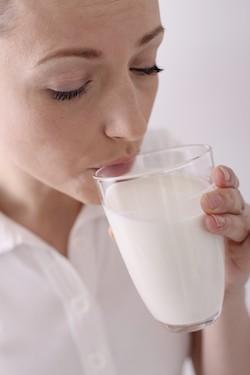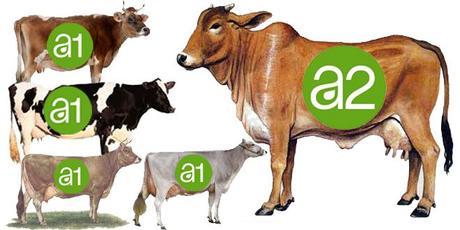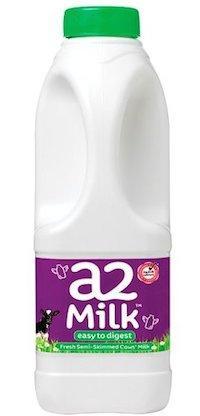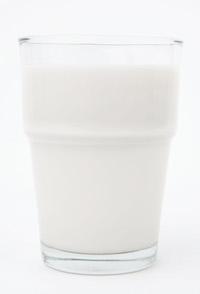
There is an ongoing debate about the nutritional value of both A1 and A2 milk.
Growing number of studies from top milk-producing countries Australia, New Zealand, and some European nations enumerate the benefits of A2 milk and the health risks associated with continuous consumption of A1 milk.
This article will look at the differences between A1 and A2 milk, as well as available evidence that support the A1 vs A2 debate.
What Is Wrong with A1 Milk?
At present, there are two types of cow’s milk available in the market, A1 and A2 milk.
The majority of cows that are being raised in the United States and other parts of the globe are A1 variety.
Milk produced by A1 cows supposedly produces opiate-like effects resulting in the development of mild to serious medical conditions (2).
Prominent professor Bob Elliot from the University of Auckland claims that a switch to A2 milk can ultimately solve all problems that 1 in every 4 Americans have in relation to dairy consumption (4).
KEY POINT: It is claimed A1 milk consumption produces harmful health effects, yet these harmful effects are not present when drinking A2 milk.
The Difference Between A1 and A2 Milk
The protein component in milk is made up of up to 80% casein (1).
Milk has several types of casein and beta casein is the second most common type casein in cow’s milk. Beta-casein comes in 13 different forms (5).

Source: Medifit Bilogicals
- A1 beta-casein comes from the most common cow breed that originated in Australia, United States, and Northern Europe. Holstein, Friesian, Ayrshire, and British Shorthorn features A1 beta-casein genetic material. A1 beta-casein can be found on all commercially-prepared milk.
- A2 beta-casein is protein found in milk produced by 'old-fashioned' cows like the Jersey, Charolais, Guernsey, and Limousin. Milk produced by other mammals such as those from human, goat, and sheep is similar to A2 dairy milk mainly due to the presence of proline (6 ,7).
A1 is considered a genetic mutation that results in the production of the compound BCM7 assumed to be causing the development of unwanted health conditions and illnesses among consumers.
When Did the A1 Mutation Start?

The A1 gene mutation began hundreds of years ago from Holstein cow breed that was then passed onto other breeds (8).
This mutation of the A1 beta-casein proved to be highly beneficial to dairy farmers who wanted to increase milk production without the added costs.
A2 milk is found in milk and dairy products produced by older cow breeds, have not been manipulated in any way. Thus many regard it as the better type of casein protein. It is found in milk we consume along with A1 milk.
A2 milk is produced by A2 Milk Company, and contains no A1 beta-casein.
KEY POINT: The difference between A1 and A2 is in the amino acid chain number 67. At this position, A2 features proline whilst A1 is linked with histidine. This mutation in the amino acid chain link of A1 milk is supposed to cause adverse effects in humans, whilst making A2 milk the healthier option.
What is BCM7?

BCM7 (Beta-casomorphin-7), an opioid peptide in A1 beta-casein is produced as a result of the breaking off of histidine in the number 67 amino acid chain during digestion (9, 10).
BCM7 is the reason why regular cow’s milk is considered to be a less healthy option than milk containing A2 beta-casein.
BCM7 found in A1 milk is known to have opioid or narcotic side effects and is identified to be the culprit of lactose intolerance in 1 out 4 Americans.
The absorption of BCM7 into the bloodstream leads to the high incidence of autism, schizophrenia, and other neurological disorders (11, 12, 13, 14).
Despite extensive and ongoing research, the extent of BCM-7 absorption into the bloodstream still remains unknown. Studies reveal that BCM-7 is absent in the blood of healthy adults, whilst presence of BCM-7 in infants is a possibility (15, 16, 17).
KEY POINT: The presence of BCM7 in A1 milk makes it a less attractive dairy option due to the problems that are assumed to develop as a result of consumption of A1 milk.
Risk of Type 1 Diabetes Mellitus
Type 1 Diabetes Mellitus is an autoimmune disease that typically develops in children. The illness is characterized by the inability of the body to produce insulin.
Based on epidemiological evidence, the consumption of A1 milk is a contributing factor in the increased risk of development diabetes type 1 among children (12, 15, 18, 19).
Human breast milk contains A2 beta-casein only whereas pasteurized milk formulations may either contain A1/A1 beta-casein or A1/A2 beta casein.

According to a 1992 observational study by Elliot RB, there was low incidence of diabetes mellitus type 1 among infants who were breastfed in the Polynesian Islands as opposed to Polynesian infants in Auckland that were supplied with commercial milk formulations containing A1 beta-casein (20).
Observational studies were insufficient to prove that A1 milk may cause type 1 Diabetes, but only showed that those who consumed more A1 beta-casein are likely to develop insulin-dependent diabetes.
There are also reports that show no difference in the effects of A1 and A2 milk in children. Lastly, a few studies claim that milk containing A1 beta-casein has no effect on prevalence of diabetes type 1 altogether (18, 21, 22, 23).
KEY POINT: A1 beta-casein is assumed to stimulate the development of type-1 diabetes in children. Observational studies reveal mixed evidence, thus requiring more research in order to confirm or deny claims.
Does A1 Milk Harm Your Heart?

According to New Zealand research conducted by CNS McLachlan, the regular intake of common milk containing A1 beta-casein inspires the development of coronary heart disease (24).
The findings of McLachlan are supported by ecological data produced after extensive testing on rabbits.
The test rabbits that were supplied with A1 beta-casein featured larger areas of fatty streaks in the aorta while those that received A2 milk came up normal.
Apart from fatty streaks, rabbits nourished with A1 milk had higher levels of LDL cholesterol as opposed to those that received A2 milk for 6 weeks (12, 19).
The experiment on rabbits clearly showed that the accumulation of fats may potentially clog and block blood vessels that may result in heart disease. Unfortunately, the relevance of these findings for humans is still up for debate (6, 25).
To date, there are only two human studies that have tested the effects of A1 beta-casein as a predisposing factor of heart disease. One study included 15 male and female test subjects with known high risk of heart disease.
The crossover design of the study meant that participants consumed both A1 and A2 beta-casein at different periods of time (26, 27).
The results derived from the study tell us that there are no serious adverse effects on heart disease risk factors. When compared alongside A2 beta-casein, A1 showcased similar effects on blood pressure levels, blood vessel function, blood fats concentration, and inflammatory markers (27).
Based on the results derived from the other study, there are no significant differences in the effects of A1 and A2 beta-casein on blood cholesterol levels (26).
KEY POINT: Despite numerous studies that point to the increased risk of coronary heart disease in animals, there are no solid evidence that can confirm the negative effects of A1 beta-casein in humans.
Does A1 Milk Cause SIDS?

The most common cause of death in infants less than one year of age is identified to be Sudden Infant Death Syndrome or SIDS. It is unexpected infant death without clear or visible cause (28).
Some researchers hypothesized that BCM-7 from A1 beta-casein may be the culprit in some cases of SIDs.
As some mothers may opt to breastfeed their babies up to 2 years of age, there are also those who prefer to provide their newborns with instant milk formulations instead (29).
In one study, high levels of BCM-7 in the bloodstream were found among infants suffering from sleep apnea or temporary breathing patterns during sleep. Sleep apnea has been linked to an increased incidence of SIDS (15).
BCM-7 penetration into a newborn’s central nervous system may potentially inhibit normal respiratory system functioning as evidenced by abnormal respiratory breathing, hypoxia, and excessive levels of carbon dioxide resulting in sudden death (30).
Results obtained from these studies also tell us that some children may be suffering from hypersensitivity issues to A1 beta-casein in cow’s milk.
More studies should be implemented before any solid conclusions can be made to connect A1 milk consumption with SIDS.
KEY POINT: Due to limited studies, there are no concrete evidence that can link SIDS to the death of infants that exclusively consumed A1 milk formulations. More research is needed to prove the hypothesis that A1 milk is a contributing factor to increased risk of sudden death in infants.
Is There a Direct Relationship Between A1 Milk and Autism?
Autism is a developmental disorder characterized by disabilities including problems with social interaction, communication, and repetitive behaviors.
It was theorized that BCM-7 plays a crucial role in the development of autism in children. Although there have been numerous studies trying to link A1 milk to autism, there are still no solid proof that can verify this hypothesis (31, 32, 33).

In a study conducted by Russian researchers, high amounts of BCM-7 were found in the urine of infants with autism that were fed with milk formula.
Over time, there were infants that showed the ability to metabolize BCM-7 at a fast rate, whilst there are those who showcased inability to process and excrete BCM-7 and other peptides altogether.
The study also reveals that those who were fed with formula milk exemplified delayed psychomotor development as well as high levels of BCM-7 in their bloodstream.
On the other hand, infants with autism that were breastfed or those under Gluten-free, Casein-free or GFCF diet displayed more developmental improvements with no traces of BCM-7 in their bloodstream (14).
Due to some observation from these studies, there are some nutritionists who have started recommending parents of children with autism to start supplementing their diets with A2 milk. Making the switch from common A1 milk to A2 milk is supposed to be beneficial for child afflicted with autism.
Major improvements have been observed among children who regularly consume A2 milk sourced from Guernsey cows due to its high A2 beta casein at 95%. Those who opted to provide their children with A2 milk also reported improvement in digestive function, communication skills, and eye contact.
Another study reveals that drinking cow’s milk over time may potentially exacerbate the symptoms among children with autism. There are also studies that showed that drinking A1 or A2 milk has no effect on overall behavior (34).
With autism, there are more than one cause to its development. There is not enough human trials that can prove the hypothesis that A1 and A2 milk have significant impact on the incidence and severity of autism symptoms (35, 36).
KEY POINT: Despite numerous studies that link autism symptoms to A1 milk consumption, researchers still need to find out more solid connections for the negative effects of A1 milk among children with autism.
Is A1 Milk the Major Cause of Lactose Intolerance?

Based on studies, 1 in 4 Americans suffer from lactose intolerance - the inability if the digestive system to process milk resulting in the development of unpleasant symptoms such as stomach upsets, diarrhea, flatulence, and bloating to name a few.
A1 and A2 milk feature the same lactose concentrations. The makers of A2 milk contend that lactose is not the real suspect for the development of lactose intolerance, but a mutation caused by A1 beta-casein, a compound found in store-brought milk and dairy products.
Some researchers say drinking A2 milk causes less digestive issues than milk containing A1 beta-casein (37, 38).
Studies that support these claims reveal that apart from lactose, there are other milk components that bring about unwanted digestive problems. It was also suggested by scientists that certain proteins present in milk may be the major suspects in some cases of milk intolerance.
In one study involving 41 men and women, results revealed that drinking A1 milk may result in softer stools than A2 milk consumption in some test subjects. Additional students in rodents implicate that A1 milk may be a predisposing factor to increased inflammation in the digestive system (39, 40, 41).
KEY POINT: Although there are reports that show positive benefits of drinking A2 milk, there is not enough data to support the hypothesis that A1 beta-casein can trigger or worsen the symptoms of lactose intolerance.
Bottom Line
The shortage of proof that switching to A2 milk intake can make a huge impact on health and wellness has made it impossible to boycott the sales, use, and continuous production of milk and dairy products from A1 cow breeds.
Even if there is solid evidence on the benefits of A2 milk and the detrimental effects of A1 milk intake, it will take years, even decades, to adapt to the raising of pure A2 cow breeds and the manufacturing of A2 milk.

